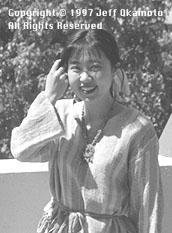
Copyright (C) 1997 Jeff Okamoto. All rights reserved.
Photo of Megumi Hayashibara is Copyright (C) 1997 Jeff Okamoto. All rights
reserved.

Welcome to issue #9 of the Hayashibara Megumi Internet Fan Club Newsletter! A new year has begun, and it's time to take a look back at 1996 and a look forward to 1997.
1996 was a very good year for seiyuu. They continue to gain mainstream acceptance, and for the seiyuu otaku, more specialized books, magazines, and CD's are being published or released.
Especially popular now are essay books by seiyuu in which the seiyuu may write about any topic that strikes their fancy.
Photo books not only show the seiyuu in fashionable clothes at beautiful locations, but are also starting to show the influence of CG, or computer graphics. Take a look at Inoue Kikuko's photo book, La Sirene for an example of this.
Also popular are photo collection magazines, which contain photos of various seiyuu. Often these photos are also accompanied by essays. Voice Gallery is an example of this kind of magazine.
Still popular are the two mainstream magazines, Seiyuu Grand Prix and Voice Animage. These magazines have the latest news about the most popular seiyuu, as well as photos from seiyuu concert tours.
More and more seiyuu are producing CD's. Fortunately, some seiyuu are very talented singers or were singers before becoming seiyuu (Orikasa Ai and Iwao Junko being the best two examples). Others became singers after becoming popular as a seiyuu. We are lucky that Miss Hayashibara is one of those singers who have become very good singers.
Seiyuu are also doing more and more radio shows. Miss Hayashibara continues with her three radio shows (more on them later). Some shows contain radio dramas (some of which become anime), others talk about the most recent computer games, and some seem to simply be a means for the seiyuu to get their voice more widely spread.
CD-ROM's are also available, but their popularity seems to be waning. The CD-ROM "Voice Collection" has stalled at nine releases, and unfortunately Miss Hayashibara is not one of those nine (the nine are: Hisakawa Aya, Tomizawa Michie, Kouda Mariko, Touma Yumi, Kusachi Fumie, Orikasa Ai, Mizutani Yuuko, Fukami Rika, and Tange Sakura). I enjoyed these, although the quality of the video and audio portions were often wildly inconsistent. My Mac's startup sound is Hisakawa Aya saying, "Welcome to Macintosh!", my beep is another Aya noise ("Hyaa!"), and the shutdown sound is a "Nani yo!" by Tomizawa Michie.
Seiyuu events are still popular attractions. Like rock groupies, some seiyuu otaku follow their favorite seiyuu as they travel cross-country, or manage to attend five separate events in a single day!
Even as I began watching anime some 15 years ago, I began keeping track of the various seiyuu who performed the voices of characters that I particularly liked or disliked.
With seiyuu becoming so popular, there are a number of schools that are churning out seiyuu by the dozen, and anime companies are hiring them because they are cheaper than hiring veteran seiyuu. Thus, the average age of working seiyuu has dropped severely, with some seiyuu barely over 18 years old.
Thus, I wind up feeling like this is a second, or perhaps third age for seiyuu. The veteran seiyuu of past years have either died (Yamada Yasuo, the voice of Lupin III), retired (Hirano Fumi, the voice of Lum), or have virtually done so (Tsuru Hiromi, the voice of Ayukawa Madoka).
Fortunately, some veterans still continue to work, providing a link to the good old days. These would include Kamiya Akira and Hidaka Noriko, to name a few. It is important to remember that the current seiyuu situation is vastly different from what it was even only 10 years ago.
At last, what you've been waiting for. I tried to be as complete as I could be, but I'm sure that I may have missed some things that she's done in the last year.
Ms. Hayashibara performed in various anime titles. These include Saber Marionette J (in which she also performed the opening and ending theme), Evangelion, Bakuretsu Hunter, Blue Seed 2, the Slayers Special, and Soreyuke! Uchu Senkan Yamato.
She continues her two radio shows, Tokyo Boogie Night, and Megumi's Heartful Station. In addition, she has a third show with Satake Masaaki, entitled Satake Masaaki's King Cram School F.
Finally, and perhaps most importantly, her latest CD Bertemu has sold over 200,000 copies.
On March 30th, Ms. Hayashibara turns 30! O-tanjoubi omedetou gozaimasu!
You can get back issues of this newsletter on the Web, both as PostScript and normal HTML. The URL for the fan club is:
http://www.tcp.com/~okamoto/hayashibara-megumi/
To contact this newsletter, send electronic mail to: okamoto@seiyuu.com.
Hayashibara Megumi Internet Fan Club / seiyuu.com!okamoto / 18 Mar 1997